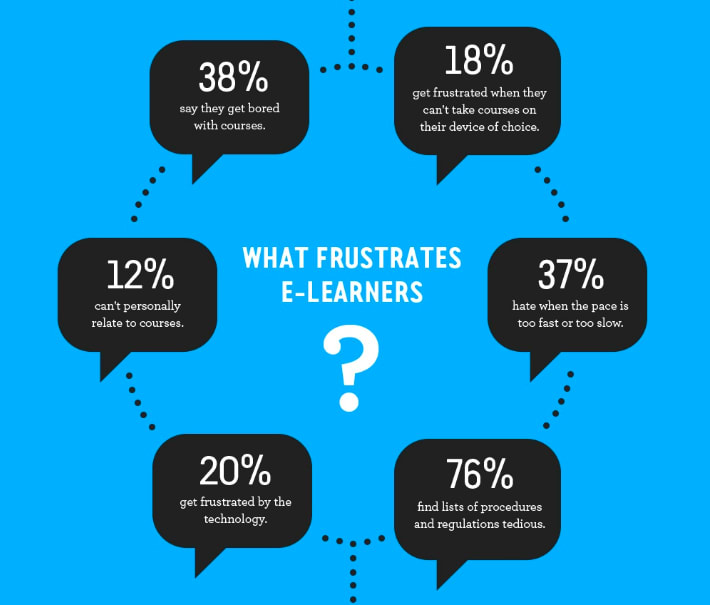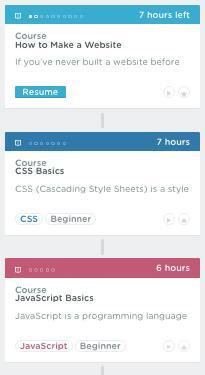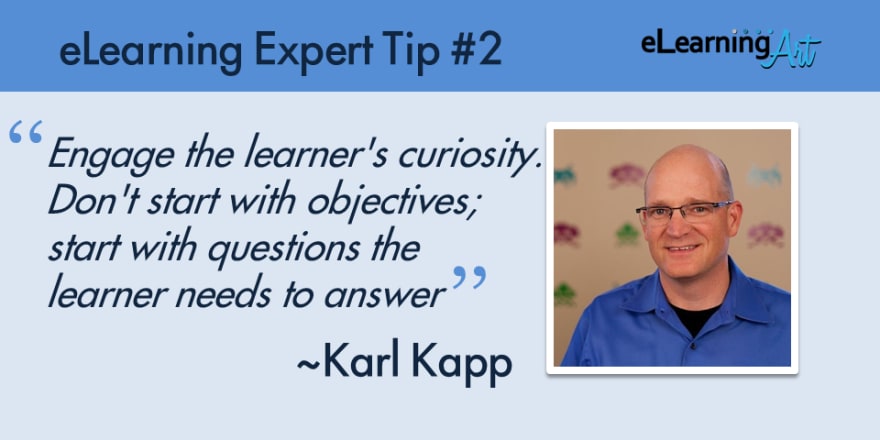Boring eLearning Apps! How to Design Them for Engagement

Chintan Bhatt
Posted on November 7, 2019

Today, different businesses and educational institutions are using e-learning apps to offer online training and teaching, which can be both formal and informal in nature. And the benefits are many.
If you take a look at the statistics, e-learning can increase retention rates by 25% to 60%.
But not all e-learning apps or courses are as engaging as they should be according to a survey. You can see it in the infographic below. E-learners become frustrated by many aspects of the courses.
Source: LearnDash
Nevertheless, the worldwide e-learning market is projected to be worth $325 Billion in 2025. So the demand for e-learning apps will still be there.
Now the question is:
How to design e-learning apps that will engage the users?
By using microlearning and gamification techniques, you can make apps more interactive and effective.
Let’s see how you can apply these techniques to design engaging e-learning apps:
1. Micro-Learning
Today’s learners have a shorter span of attention. In fact, it is said that after one hour, people retain less than half of the information presented. Thus, providing smaller chunks of data ensures higher receptivity and information retention.
Micro-learning can involve watching small instructional videos on YouTube, flashcard learning, solving mini-training quizzes, and receiving small bits of information via SMS, email, etc.
The infographic below reveals that the corporate workplace loves micro-learning as it enhances learner engagement by 50%.
Source: Commlabindia
When you combine content that’s designed for micro-learning and an app designed to deliver this content in the most effective way possible, you can create an effective and engaging e-learning app.
2. Gamification
The gamification market is expected to reach $1.2 billion by 2020. It is an essential technique incorporated in progressive organizations’ eLearning strategies.
Gamification involves the process of incorporating something that already exists, for instance, a website or an enterprise application with game mechanics to motivate participation, engagement, and loyalty.
Gamification applies the data-driven techniques used by game designers to non-game experiences, thus motivating actions that add value to your business.
Also, it allows users to leverage several of their natural human desires- socializing, learning, mastery, achievement, and status.
Statistics reveal that 80% of US workers believe game-based learning is more engaging while company gamification training features can increase the level of employee engagement by 60% and enhance productivity by up to 50%. Also, according to the European CEO, 50% of business transformation programs fail due to poor employee engagement.
Which e-learning platforms are doing it right?
Below are some popular e-learning services which have been able to retain user’s engagement with their UX strategies and best practices.
1. Treehouse
Treehouse is a popular e-learning service offering courses in web design, coding, and business. As you can see in the image below, Treehouse has progress indicators to keep users engaged.
Their course syllabus is set in a timeline design that allows you to see how much time each step takes. This feature allows you to decide whether you have enough time to commit to each module, and also serves as a motivator by providing a countdown to completing each section. This feature increases the chances of completing the tasks.
Treehouse also incorporates the gamification technique and awards you with points as you complete your lessons and interact with the community (as shown above).
The points are divided into two categories- Achievements and Forum.
2. Udemy
Udemy offers the highest number of online courses that totals to over 45,000 courses. Their courses include everything starting from Business to IT & Software and Health & Fitness.
So what technique does Udemy apply to keep students engaged?
As you can see in the image above, Udemy’s course overviews show a completion tracker bar. It serves as a motivator and keeps you engaged as you can see your overall progress in any class.
3. Duolingo
A popular language-learning platform, this e-learning service offers 68 courses, covering 23 languages.
Starting from incorporating progress indicators to giving immediate feedback and using the gamification technique, Duolingo seems to be doing everything possible to keep its users engaged.
The image above is of Duolingo’s progress bar that showcases how many lessons you have completed, your daily goal, skill-strength, and fluency score. The progress bar can go backward if you discontinue practicing and keep your language skills sharp.
It also provides feedback when you take your language test and answer a question incorrectly.
And it gives you three “lives” that disappear one by one as you answer a question incorrectly. You have to start over if you lose all your “lives.”
All three e-learning services listed above are employing the right techniques to increase user engagement. No wonder their users keep increasing.
Some Expert Tips on Creating Engaging E-Learning
Below are some expert tips on how to create engaging e-learning courses that you can apply when designing e-learning apps as well.
Students come to you as they are curious. If you can’t engage with their curiosity from the start, they will lose their interest, and eventually, you will lose them.
Karl Kapp is an Instructional Technology Graduate Professor at Bloomsburg University, renowned for his books, courses, writing, consulting, and talks on interactive learning, games, and gamification.
Patti, the Founder of Learning Peaks, a published author, and a frequent speaker at eLearning conferences advise you to solve genuine learning needs and be really interested in your students.
Lieve, a Freelancer at Lilybiri Consultant Trainer, points out that a boring e-learning app is not going to do any good.
Winding-Up
Are you planning to incorporate an e-learning app in your organization or business? Or do you want to offer e-learning courses to school students through your apps? Make sure that your app is engaging in order to meet your objectives.
The prospect of building a new app can be overwhelming but one can always collaborate with agencies to craft intuitive experiences and design apps that retain user engagement.
Moreover, it is like an investment. Reportedly, IBM saved around $200 million after switching to e-learning. So, don’t delegate and leverage what e-learning has to offer today.

Posted on November 7, 2019
Join Our Newsletter. No Spam, Only the good stuff.
Sign up to receive the latest update from our blog.
Related

November 28, 2024

November 28, 2024












